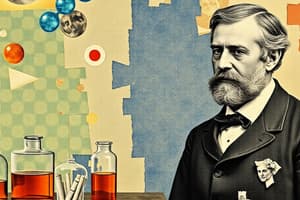Podcast
Questions and Answers
What determines the identity of an element?
What determines the identity of an element?
- The mass number of the atom
- The number of protons in the nucleus (correct)
- The total number of subatomic particles
- The number of neutrons in the nucleus
Which particle has a charge of zero?
Which particle has a charge of zero?
- Neutron (correct)
- Electron
- Proton
- Positron
How do different isotopes of an element vary?
How do different isotopes of an element vary?
- By the number of electrons they have
- By their atomic number
- By their chemical properties
- By the number of neutrons in the nucleus (correct)
What is the mass number of an atom?
What is the mass number of an atom?
What is the average atomic mass of carbon with carbon-12 contributing 98.90% and carbon-13 contributing 1.10%?
What is the average atomic mass of carbon with carbon-12 contributing 98.90% and carbon-13 contributing 1.10%?
What did Thomson conclude about the beam observed in his experiments?
What did Thomson conclude about the beam observed in his experiments?
What is the primary characteristic of nucleons as described in the atomic theory?
What is the primary characteristic of nucleons as described in the atomic theory?
Which experiment led to Rutherford's discovery of the atomic nucleus?
Which experiment led to Rutherford's discovery of the atomic nucleus?
What does the structure of the atom encompass?
What does the structure of the atom encompass?
What charge does a neutron carry?
What charge does a neutron carry?
According to Rutherford, which statement about the atom is true?
According to Rutherford, which statement about the atom is true?
What was the contribution of James Chadwick to atomic theory?
What was the contribution of James Chadwick to atomic theory?
Which of the following particles has a positive charge?
Which of the following particles has a positive charge?
What concept did Democritus introduce regarding the composition of matter?
What concept did Democritus introduce regarding the composition of matter?
Which statement is part of John Dalton's Atomic Theory?
Which statement is part of John Dalton's Atomic Theory?
What was J.J. Thomson's significant contribution to atomic theory?
What was J.J. Thomson's significant contribution to atomic theory?
How did Thomson demonstrate the existence of electrons?
How did Thomson demonstrate the existence of electrons?
In Thomson's experiment, what effect did adding an electric field have on the beam?
In Thomson's experiment, what effect did adding an electric field have on the beam?
According to Dalton, what happens to atoms during a chemical reaction?
According to Dalton, what happens to atoms during a chemical reaction?
What characteristic did Dalton attribute to atoms of the same element?
What characteristic did Dalton attribute to atoms of the same element?
What model of the atom did Dalton propose?
What model of the atom did Dalton propose?
Flashcards are hidden until you start studying
Study Notes
Atomic Structure Overview
- Early theories proposed that all matter is composed of atoms, the smallest indivisible particles.
- Democritus (460 BC) introduced the concept of "atomos," meaning uncuttable, suggesting two components of the world: atoms and empty space.
John Dalton's Atomic Theory (1804)
- All matter consists of atoms, which are indivisible and uniform within each element.
- Compounds are formed through combinations of different kinds of atoms.
- Visualized atoms as solid spheres using the "Billiard Ball" model.
J.J. Thomson and Electron Discovery (1897)
- Discovered the electron, revealing that atoms contain smaller components.
- Utilized a cathode ray tube, demonstrating that electric current creates a beam moving from negative to positive.
- Proposed the "Plum Pudding" model, indicating electrons embedded within a positively charged "pudding."
Eugen Goldstein (1850-1930)
- Discovered canal rays, leading to the identification of protons as positively charged particles within atoms.
Ernest Rutherford's Gold Foil Experiment (1913)
- Conducted an experiment that deflected alpha particles, leading to the discovery of the nucleus.
- Concluded the atom is mostly empty space with a small, dense positively charged nucleus.
James Chadwick's Contribution
- Confirmed the existence of neutrons, neutral particles with mass approximately equal to protons.
- Defined nucleons, being protons and neutrons in the atomic nucleus, accounting for most of an atom's mass.
Structure of the Atom
- An atom consists of a nucleus (protons and neutrons) and an electron cloud surrounding it.
- Protons possess a positive charge, neutrons are neutral, and electrons carry a negative charge with negligible mass.
Subatomic Particles Summary
- Electron: Charge -1.602 x 10^-19 coulombs, mass 9.108 x 10^-28 grams.
- Proton: Charge +1.602 x 10^-19 coulombs, mass 1.673 x 10^-24 grams.
- Neutron: Charge 0, mass 1.675 x 10^-24 grams.
Counting Atoms
- Atomic Number: Number of protons, defines the element.
- Mass Number: Sum of protons and neutrons; measured in g/mol.
Isotopes
- Variants of the same element differing in neutron count, leading to different mass numbers.
- Common example: Carbon-12 and Carbon-13, where Carbon-12 is more abundant.
Average Atomic Mass Calculation
- Average atomic mass determined using a weighted average of isotopes based on their abundance.
- Example problem illustrates how to calculate average atomic mass for carbon using its isotopes.
Studying That Suits You
Use AI to generate personalized quizzes and flashcards to suit your learning preferences.




